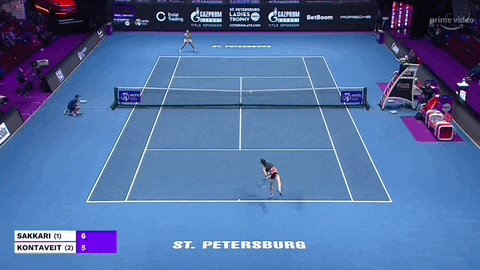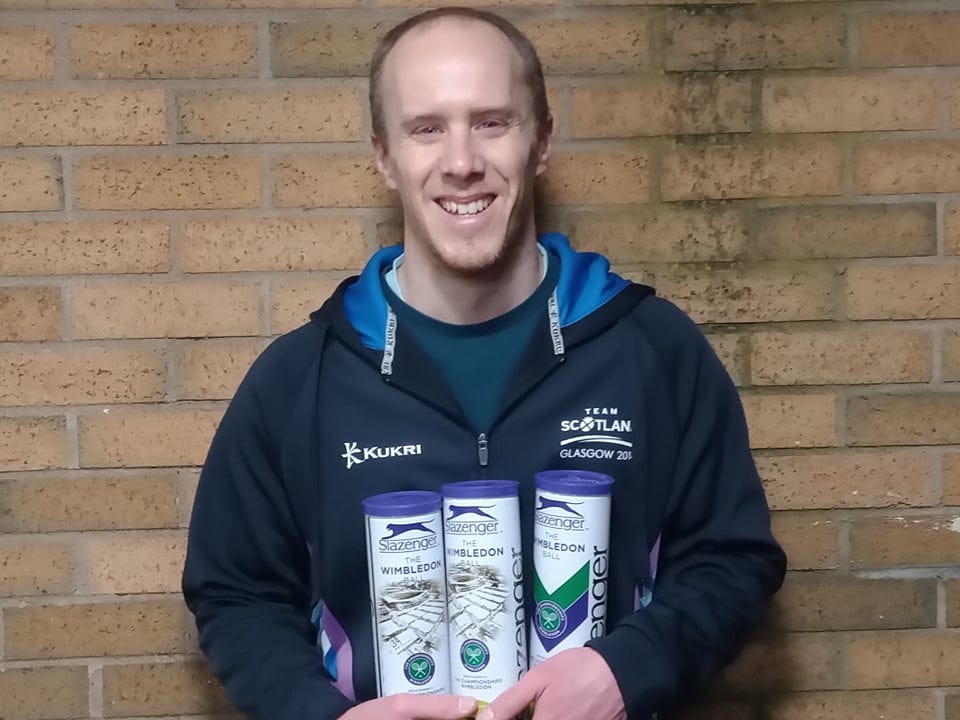Maria Sakkari: Finding Positives In Losses
Though Maria Sakkari lost to Anett Kontaveit in last Sunday's St. Petersburg Open final, she can take heart in finding ways to make her game work against one of the most form players on tour.
A bit of a different look today.
Last Sunday, Maria Sakkari lost to Anett Kontaveit in the final of the St. Petersburg Open. It was a three-hour epic that ended with Kontaveit scraping through in three topsy-turvy sets.
Today, I’m going to analyse Sakkari’s loss rather than analysing Kontaveit’s win - I feel obliged given we learnt more about Sakkari than we did about Kontaveit.
Enjoy!
Context Going Into The Match
To understand the gravity of Sakkari’s performance against Kontaveit, a little background is required.
Anett Kontaveit: Indoor Queen
Sakkari couldn’t have been against anyone tougher in the final.
Anett Kontaveit was on a 19-match winning streak indoors, winning Ostrava, Moscow, Cluj-Napoca and her four matches previous to the final in St. Petersburg.
With the help of Dmitry Tursunov last August, Kontaveit had learned to use her forehand to devastating effect, her preferred pattern of play to go big cross-court and finish into the ad-court.
In steady indoor conditions, Kontaveit has repeatedly been able to control the power of her forehand dropping just two sets amidst her 19-match win streak. One of these matches was a 6-2 7-5 win over Sakkari in the final of Ostrava.

Maria Sakkari: Powerful Yet Predictable
Sakkari is at her very best playing meat and potatoes tennis.
She had the season of her life last year, reaching a career-high of #6 in the world, enacting her plan A.
Serve: Sakkari prefers to hit a slice first-serve swinging away from her opponent’s forehand/lefty backhand. When she can get into a rhythm with this serve, she doesn’t leave her opponent guessing, she just bombs away with this one until her opponent can come up with a response.
In the 12 Sakkari wins with data available on them since the beginning of 2021 on tennisabstract.com, Sakkari hit her first-serve into her opponent’s forehand side 62% of the time. Against Swiatek at the French Open as an extreme example, she hit every single one of her first-serves in the deuce court to Swiatek’s forehand. When she was predictable, she was powerful - Sakkari held 78% of her service games last year, the fifth-best on tour.
In the 8 Sakkari losses available, Sakkari hit her first-serve into her opponent’s forehand 40% of the time. In two of her losses to Kontaveit that year in Ostrava and at the Grampians Trophy, this dropped even further, hitting this serve an average of 25% of the time.
Rally: Sakkari doesn’t take on a ton of risk from the baseline hitting relatively more predictable strikes than most of the tour.
The Forehand: From 67 charted Sakkari matches throughout her career on tennisabstract.com, Sakkari hits 5% more of her forehands down the middle of the court than the rest of the tour. Granted, it’s the shot that does most of the damage as she also has the ability to hook a heavy angled forehand cross-court but she chooses to go more linear than risky with this shot than many of her peers.
The Backhand: From the 12 wins mentioned earlier, Sakkari directed her backhand inside-out or down the line (i.e. aggressively to the deuce court) 7% of the time. In the 8 losses, this shot percentage increased to 14% - when Sakkari was struggling last year, she went for the aggressive backhand into the deuce court far more often, harder to pull off than the cross-court backhand.
Compared to the rest of the tour? Tennisabstract.com have the tour’s average backhands directed inside-out or down the line at 20% - Sakkari was at 14% in those 8 matches lost and 7% in those 12 matches won.
When Sakkari was winning last year, she wasn’t trying to bluff her opponent. She was playing a brand of aggressive tennis that was predictable yet effective in its level of execution.
On the flip side, with her back against the wall, Sakkari often struggled to adapt. Though she had a brilliant 6-7 record coming from a set down in 2020 thanks to the coaching work of Mark Petchey, in 2021, statistically her best year, this stat nose-dived to 3-16.
Sakkari had barged her way into the top-10 playing a brand of aggressive tennis she was comfortable with but when she was forced to stray from her usual game plan, she couldn’t find the answers.
Following so far?
This context sets the scene for why this loss was so interesting…
Finding Positives In Losses
With the conditions ideal for Kontaveit, the match could have been done and dusted in two tidy sets. In fact, this had happened the last time they’d played indoors in the final of Ostrava, Sakkari losing that day 6-2 7-5.
In St. Petersburg however, Sakkari adjusted her tactics from Ostrava, keeping the scoreline incredibly tight - she eventually lost 5-7 7-6 (4) 7-5 even serving for it in the third set.
How did she keep things closer with Kontaveit potentially comfortable indoors?
Backhand Direction
In Ostrava, we’d seen Sakkari try to find Kontaveit’s exploitable forehand in the wrong manner 1.
The majority of her backhands were going cross-court (54%), clearly not keen to go into the forehand too often - when she did go into this wing, she went tight to the sideline, taking it down the line or inside-out 21% of the time (that’s a lot for Sakkari - remember 7% in the 12 matches won?).
It worked. She won 13 of the 18 points that included one of these backhands. The problem was she couldn’t set up an attackable ball often enough. She was happy to trade cross-court before finding the right backhand to pull the trigger on - she wasn’t gifted this opportunity frequently though, Kontaveit more than capable of attacking with her backhand cross-court as well as her forehand.
She didn’t take advantage of the middle of the court, generally avoiding playing central balls on purpose.
Her adjustment in St. Petersburg was crafty. She went cross-court far less often (54% to 35%), opting to rush with her backhand into the right hip of Kontaveit in an attempt to jam her up - her backhands down the middle percentage raised from 25% in Ostrava to 48% in St. Petersburg.


By infrequently going cross-court with her backhand, Sakkari went into the Kontaveit forehand earlier to a safer target. This stopped Kontaveit from setting up her favourite pattern of play with a forehand cross-court. Consequently, Kontaveit won 46% of the points that included either her forehand down the line or inside-out, unheard of indoors in the last half of 2021 (77% in Ostrava).
Kontaveit went from winning 71% of her points that included any forehand shot in Ostrava to 53% in St. Petersburg.
The beauty of this tactical adjustment is how much it complements Sakkari’s game. Yes, she still took on risk every now and then, going down the line or inside-out with the backhand 17% of the time, but it was only as a result of setting up the shot with less risky linear shots down the middle of the court - she wasn’t as predictable from the back of the court whilst maintaining a degree of safety to most of her backhands.
Unpredictable Serve Direction
In Ostrava, Sakkari was too uncomfortable on serve.
She chose to hit her first-serve into Kontaveit’s forehand 22% of the time (far, far less than the 62% we mentioned earlier when she was winning matches last year), trying to avoid that wing of Kontaveit entirely.
In St. Petersburg, Sakkari still avoided the forehand but gravitated more towards an even split, directing first-serve into the forehand 37% of the time.
The result was a serve that was far less predictable.
Sakkari returned serves in Ostrava: 60/73 = 82%
Sakkari returned serves in St. Petersburg: 89/123 = 72%
Okay, there’s sound logic in avoiding your opponents strength but Sakkari’s serve became anticipatable. In Ostrava, 10% more of her serves were returned than in St. Pete’s, Kontaveit able to hit a winner or force an error in 2-6 shots at less than half the rate she could in Ostrava.

Too Good From Kontaveit
… So how did Sakkari lose?
In the end, she was narrowly outplayed by the form player in these conditions - Kontaveit is still a better player from the baseline indoors but Sakkari found a way to trouble her. There were contributions from both parties to the final result...


… but realistically, this could have just as easily have been a winning game plan against the Estonian, Sakkari winning five more points overall.
Sakkari forced Kontaveit to feel uncomfortable and adjust rather than the other way around. She never had to play miles outside of her comfort zone, still hitting linear shots but varying the direction enough to force Kontaveit into finding forehands that weren’t necessarily on, into getting up in the point using her backhand (Kontaveit finished the match winning a higher percentage of points that included a backhand than a forehand, 59% to 53%).
Kontaveit stepped up because she was brimming with confidence and form in these conditions but Sakkari deserves a ton of praise for forcing the issue.
Maria Sakkari’s 2022
Though she lost this match, Maria Sakkari should take heart in this loss.
She found a way to use her preferred brand of tennis to nearly scrape a win over Anett Kontaveit indoors, one of the toughest challenges in tennis right now.
Though she varied her game, she was still finding a way to make the strengths of her serve and her groundstrokes effective plays against Kontaveit i.e. keeping the serve varied enough that her slice serve was unpredictable and directing the backhand away from the deuce court sideline but pacey to the Kontaveit forehand to set up attackable shots.
It made me very excited for her 2022. Whilst we may not see a total overhaul in her rigid style of play immediately, it’s a good indication that Sakkari is finding new ways to make her tennis work against the very best in the world.
Head up Maria - the best is surely yet to come 🇬🇷
The winner of the latest On The Line prize draw is PJ - he wins three tins of Slazenger Wimbledon tennis balls!
If you share the latest On The Line post or subscribe to the blog for free, you'll be entered into the next prize draw. Winner to be announced in April!
Also, we’re moving home! We are set to move to onthelinetennis.uk in a number of weeks. Your new subscriber request may go to junk mail so PLEASE look out for it!
Follow me on Facebook (@onthelinetennisblog), Twitter (@jackedward1994) and Instagram (@jack221194)!
Kontaveit’s strength is her forehand but, given less time, it is prone to being rushed. We saw Clara Tauson hitting into the hip of Kontaveit on the quicker courts of the Australian Open to great effect.






